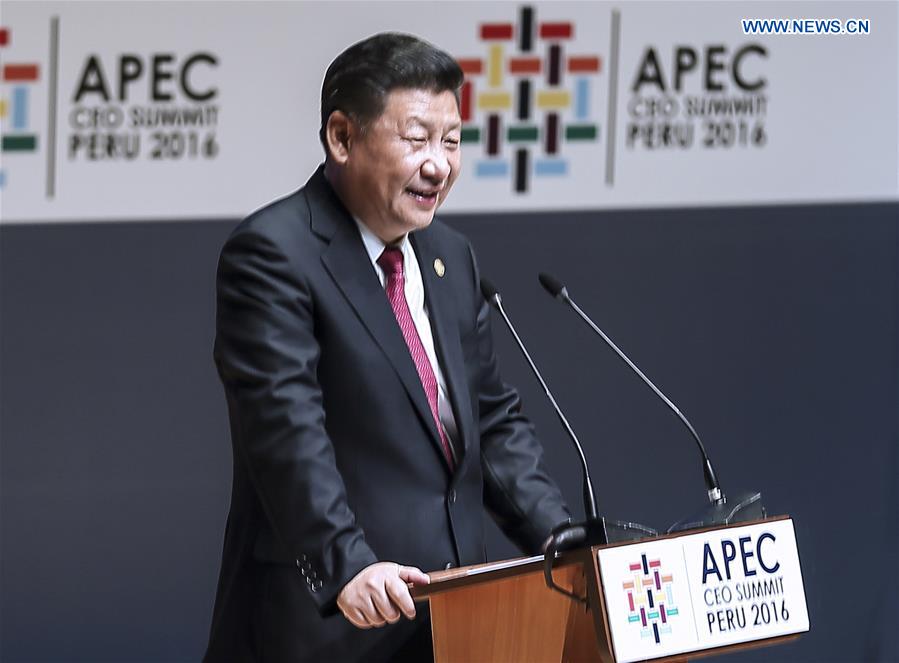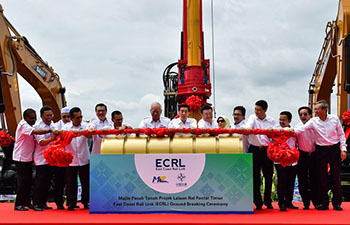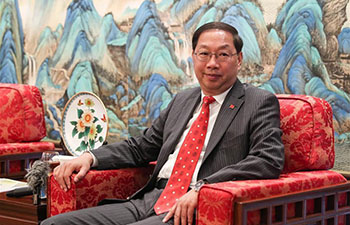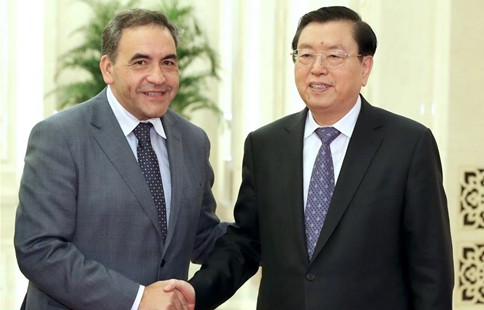 ?
?Chinese President Xi Jinping delivers a keynote speech at the Asia-Pacific Economic Cooperation (APEC) CEO Summit in Lima, Peru, Nov. 19, 2016. (Xinhua/Lan Hongguang)
by Fei Liena, Liu Tong
BEIJING, Nov. 20 (Xinhua) -- With the theme of "Quality Growth and Human Development," the ongoing Asia-Pacific Economic Cooperation (APEC) Economic Leaders' Meeting needs China's initiatives to reach its goals.
Chinese President Xi Jinping is now in Lima, Peru to attend the annual APEC Economic Leaders' Meeting, scheduled for Saturday and Sunday, and has delivered a keynote speech at the APEC CEO Summit on Saturday.
In his speech, Xi called on the 21 APEC member economies to promote an open and integrated economy, enhance connectivity to achieve interconnected development, boost reform and innovation to create more internal driving force, and promote win-win cooperation to forge strong partnerships.
ASIA-PACIFIC INTEGRATION
This year marks an important step in the development of the Free Trade Area of the Asia-Pacific (FTAAP), as a collective strategic study on the FTAAP was concluded before the APEC leaders' meeting.
Based on the study, APEC leaders will decide on their next move.
"It can be said that we are becoming increasingly clear about what the FTAAP will be like and increasingly concrete steps are being taken," said Liu Chenyang, director of the APEC Study Center at Nankai University based in Tianjin, China.
The idea of creating the FTAAP was proposed eight years ago and was officially launched at the Beijing APEC summit in 2014. The FTAAP engages all APEC members, thus saving the Asia-Pacific region from the negative impacts of free trade agreements (FTAs) contending for members and viciously competing among themselves.
"As a high-level FTA arrangement that covers a wide range of areas, the FTAAP will hopefully solve problems such as inconsistency in rules of origin and different FTAs dedicated to different areas, thus reducing the costs of implementing FTAs," said Liu.
"The TPP (Trans-Pacific Partnership), for example, leads to vicious competition. Once the FTAAP becomes reality, it will help address problems arising from a mass of intertwined FTAs, and push forward the integration of a regional economy," he added.
Economic modelling in 2014 shows global income gains from the FTAAP would be more than eight times higher than those from the TPP.
The Asia-Pacific region has always been an important platform for China's foreign trade. Most of its trade volume and foreign investment come from APEC members. China's economic development largely benefits from the regional economy and cooperation, and China's development also injects impetus into the APEC organization.
According to an estimate of the International Monetary Fund, China's contribution to the Asian economy has already exceeded 50 percent. With every percent of growth of the Chinese economy, Asia's economy rises 0.3 percent. China and the rest of the Asia-Pacific are indeed interdependent, so excluding China from any Asia-Pacific trade bloc would be unrealistic.
"Now that the U.S. is apparently turning inward (with Donald Trump's election victory), it is especially important for China to take the driver's seat in terms of pushing for greater free trade in the region, which benefits everybody," said Oh Ei Sun, an analyst at Singapore's Nanyang Technological University.
REGIONAL CONNECTIVITY
The APEC Connectivity Blueprint 2015-2025, a significant action plan for the Asia-Pacific's long-term development, was adopted at the Beijing APEC meeting in 2014.
At last year's APEC summit in Manila, the Philippines, Xi announced that China has established and put into operation the Silk Road Fund, and proposed to launch the Asian Infrastructure Investment Bank (AIIB) with an authorized capital of 100 billion U.S. dollars, an important platform supporting regional connectivity.
In June 2016, the bank approved its first four loans, totaling 509 million dollars, to fund power, housing and transportation projects in Bangladesh, Indonesia, Pakistan and Tajikistan.
Even before the establishment of the AIIB, China had already sought increased cooperation with related countries to promote connectivity in the region. The launch of China-Thailand and China-Laos railway projects marked a milestone in stepping up connectivity in the Asia-Pacific region.
China has recently proposed the evaluation mechanism on the implementation of the APEC Connectivity Blueprint, which has been approved by the APEC senior officials' meeting, said Zhang Jun, director-general of the International Economic Affairs Department of the Foreign Ministry.
"On the basis of that, we'll continue to push forward regional connectivity in areas such as e-commerce, harbor networks, environmentally conscious supply chains, and cross-border education," he said.
"We are also trying to dovetail regional connectivity with China's Belt and Road Initiative," he added.
According to Liu, this year's APEC meeting is expected to push forward the implementation of the blueprint and ensure progress is delivered in a prompt manner. With improvements in the implementation mechanism and more sources of funding, more achievements are expected in enhancing connectivity.
INNOVATIVE DEVELOPMENT & STRUCTURAL REFORM
Economic reform and innovation-driven growth are highlighted on various occasions, including the APEC and G20 meetings. These concepts are emphasized against the backdrop of the global economy still struggling to recover from the financial crisis.
Despite the consensus, it is a challenge to boost technical innovation and find new sources of economic growth. China has placed special emphasis on transforming economic development modes and innovation-driven growth in its blueprint for economic and social development in the 2016-2020 period. So have other countries in the Asia-Pacific region, which has long served as an engine of the world economy.
Therefore, China's appeal for innovation-driven growth and structural reform is in line with its own conditions and the region's demands. Its appeal has won recognition from other APEC economies.
For years the Chinese government has been releasing supportive policies and measures for innovative entrepreneurship and supply-side reform, resulting in a steady gross domestic product (GDP) growth rate of 6.7 percent, a retreat of excess capacity, and booming high-tech, service and other new industries.
"With economic restructuring, the initiative of innovation-driven growth and development of free trade zones, China boasts an increasingly opened-up and transparent market with greater market potential and improved market environment," said Liu.
"It is expected that the Lima APEC summit will coordinate and lead the drive of innovation and reform, and produce real results," he added.
For Ignacio Cortes, coordinator of the Laboratory for Trade, Economics and Business Analysis at the National Autonomous University of Mexico, the Lima APEC summit will be instrumental in invigorating the world economy, and China will play a prominent role.










